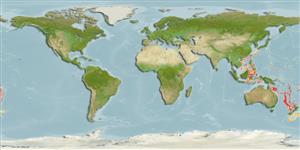>
Lophiiformes (Anglerfishes) >
Oneirodidae (Dreamers)
Etymology: Dermatias: Greek, 'derma' or 'dermatos' = skin or leather (alluring to its integument, being "naked, very loose, and soft") (Ref. 86949); platynogaster: From the Latin for horrible (Ref. 33626).
More on authors: Smith & Radcliffe.
Environment: milieu / climate zone / depth range / distribution range
Ecologia
marino batipelagico; distribuzione batimetrica 549 - 1342 m (Ref. 51262). Tropical
Western Pacific: the Philippines and Magellan Seamounts (east of Mairiana Is.).
Size / Peso / Age
Maturity: Lm ? range ? - ? cm
Max length : 17.5 cm SL (female)
Short description
Morfologia | Morfometria
Raggi dorsali molli (totale): 6; Raggi anali molli: 4. No males and larvae are known. Diagnostic characters refer to metamorphosed females, which differ from other species in the family Oneirodidae by having an unusually deep caudal peduncle (21.6-23.8% SL); blunt and short snout, highly convex frontals forming an extremely short head (29.8-30.5% SL); few teeth in jaws (20-32 in the upper jaw, 20-31 lower). Metamorphosed females are also distinguished by the following set of characters: presence of vomerine teeth; well-developed sphenotic spines (length 3.4-3.6% SL), directed dorsolaterally; a stout symphysial spine on lower jaw; hyomandibular with double head; well-developed quadrate spine (length 4.5-5.0% SL); articular spine less than half length of quadrate spine; posterior margin of opercle deeply notched; long and narrow subopercle, dorsal end tapering to a point (posterior margin without indentation), ventral end oval in shape (no anterior spine or projection); caudal-fin rays with no internal pigmentation; illicium distinctly longer than length of esca bulb; pterygiophore of illicium emerging on snout from between fontal bones, anterior end exposed, posterior end concealed beneath skin; well-developed first dorsal-fin ray ; D 6; A 4; pectoral -fin rays 15-16; short and broad pectoral-fin lobe (length 8.6-8.9%SL) shorter than longest rays of pectoral fin (19.4-19.9% SL); skin apparently naked, no dermal spinules; darkly pigmented skin of caudal peduncle extending well past base of caudal fin (specimens 2:13.4-15.1 cm SL) (Ref. 51262).
Life cycle and mating behavior
Maturità | Riproduzione | Deposizione | Uova | Fecundity | Larve
Pietsch, T.W. and V.E. Kharin, 2004. Pietschichthys horridus Kharin, 1989: a junior synonym of Dermatias platynogaster Smith and Radcliffe, in Radcliffe, 1912 (Lophiiformes: Oneirodidae), with a revised key to Oneirodid genera. Copeia 2004(1):122-127. (Ref. 51262)
IUCN Red List Status (Ref. 130435)
Threat to humans
Harmless
Human uses
Informazioni ulteriori
Nomi ComuniSinonimiMetabolismoPredatoriEcotossicologiaRiproduzioneMaturitàDeposizioneSpawning aggregationFecundityUovaEgg development
Age/SizeAccrescimentoLength-weightLength-lengthLength-frequenciesMorfometriaMorfologiaLarveDinamica popolazioni larvaliReclutamentoAbbondanzaBRUVS
BibliografiaAcquacolturaProfilo di acquacolturaVarietàGeneticaElectrophoresesEreditarietàMalattieElaborazioneNutrientsMass conversion
CollaboratoriImmaginiStamps, Coins Misc.SuoniCiguateraVelocitàModalità di nuotoArea branchialeOtolithsCervelliVista
Strumenti
Special reports
Download XML
Fonti Internet
Estimates based on models
Preferred temperature (Ref.
123201): 4.8 - 7.1, mean 5.8 °C (based on 114 cells).
Phylogenetic diversity index (Ref.
82804): PD
50 = 1.0000 [Uniqueness, from 0.5 = low to 2.0 = high].
Bayesian length-weight: a=0.01995 (0.00906 - 0.04395), b=3.01 (2.83 - 3.19), in cm total length, based on all LWR estimates for this body shape (Ref.
93245).
Trophic level (Ref.
69278): 4.0 ±0.5 se; based on size and trophs of closest relatives
Resilienza (Ref.
120179): Medio, tempo minimo di raddoppiamento della popolazione 1.4 - 4.4 anni (Preliminary K or Fecundity.).
Fishing Vulnerability (Ref.
59153): Low vulnerability (11 of 100).
